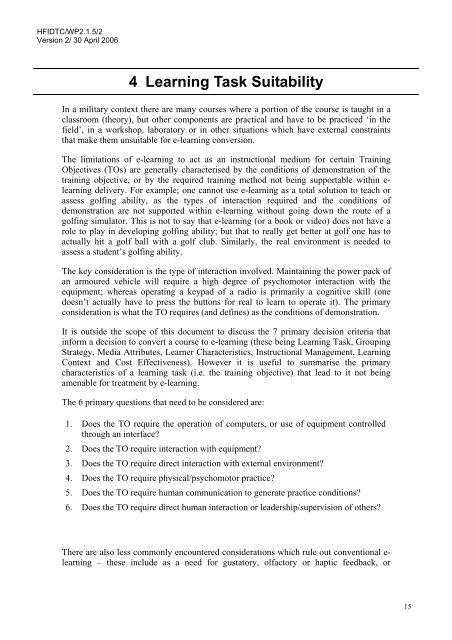E-learning Instructional Design Guidelines - Human Factors ...
E-learning Instructional Design Guidelines - Human Factors ...
E-learning Instructional Design Guidelines - Human Factors ...
Create successful ePaper yourself
Turn your PDF publications into a flip-book with our unique Google optimized e-Paper software.
HFIDTC/WP2.1.5/2<br />
Version 2/ 30 April 2006<br />
4 Learning Task Suitability<br />
In a military context there are many courses where a portion of the course is taught in a<br />
classroom (theory), but other components are practical and have to be practiced ‘in the<br />
field’, in a workshop, laboratory or in other situations which have external constraints<br />
that make them unsuitable for e-<strong>learning</strong> conversion.<br />
The limitations of e-<strong>learning</strong> to act as an instructional medium for certain Training<br />
Objectives (TOs) are generally characterised by the conditions of demonstration of the<br />
training objective, or by the required training method not being supportable within e-<br />
<strong>learning</strong> delivery. For example; one cannot use e-<strong>learning</strong> as a total solution to teach or<br />
assess golfing ability, as the types of interaction required and the conditions of<br />
demonstration are not supported within e-<strong>learning</strong> without going down the route of a<br />
golfing simulator. This is not to say that e-<strong>learning</strong> (or a book or video) does not have a<br />
role to play in developing golfing ability; but that to really get better at golf one has to<br />
actually hit a golf ball with a golf club. Similarly, the real environment is needed to<br />
assess a student’s golfing ability.<br />
The key consideration is the type of interaction involved. Maintaining the power pack of<br />
an armoured vehicle will require a high degree of psychomotor interaction with the<br />
equipment; whereas operating a keypad of a radio is primarily a cognitive skill (one<br />
doesn’t actually have to press the buttons for real to learn to operate it). The primary<br />
consideration is what the TO requires (and defines) as the conditions of demonstration.<br />
It is outside the scope of this document to discuss the 7 primary decision criteria that<br />
inform a decision to convert a course to e-<strong>learning</strong> (these being Learning Task, Grouping<br />
Strategy, Media Attributes, Learner Characteristics, <strong>Instructional</strong> Management, Learning<br />
Context and Cost Effectiveness). However it is useful to summarise the primary<br />
characteristics of a <strong>learning</strong> task (i.e. the training objective) that lead to it not being<br />
amenable for treatment by e-<strong>learning</strong>.<br />
The 6 primary questions that need to be considered are:<br />
1. Does the TO require the operation of computers, or use of equipment controlled<br />
through an interface?<br />
2. Does the TO require interaction with equipment?<br />
3. Does the TO require direct interaction with external environment?<br />
4. Does the TO require physical/psychomotor practice?<br />
5. Does the TO require human communication to generate practice conditions?<br />
6. Does the TO require direct human interaction or leadership/supervision of others?<br />
There are also less commonly encountered considerations which rule out conventional e-<br />
<strong>learning</strong> – these include as a need for gustatory, olfactory or haptic feedback, or<br />
15
















